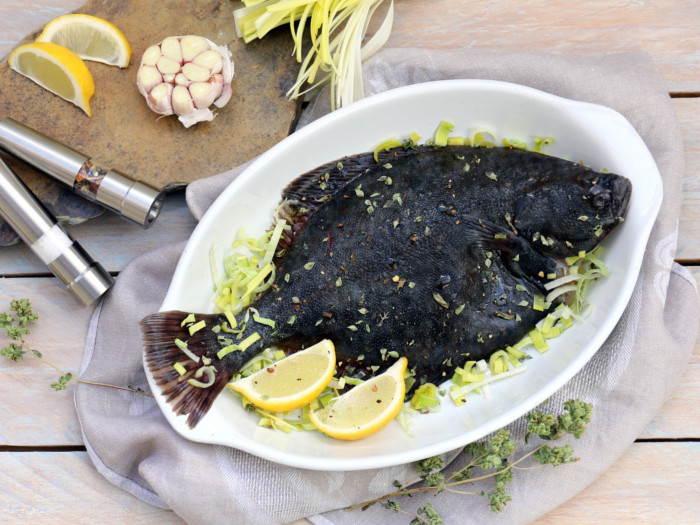Turbot fish is a popular seafood dish in some parts of the world, but before you dig into this delectable fish, you should understand the nutrients and potential health benefits.
What is Turbot?
Turbot is a type of flatfish that is native to waters of the Mediterranean and North Atlantic, belonging to the Scophthalmidae family. Scientifically known as Scophthalmus maximus, this fish has a flat, asymmetrical body, can grow up to 3.5 feet in length, and can weigh more than 50 pounds. When cooked, this healthy fish has bright, firm, white flesh and a mild flavor that is unlike of the usual fish flavor. [1]
Nutritional Facts
When it comes to nutrition it has a good amount of calories, as well as fat, 1/4 of which is made up of saturated fat. This fish is also an excellent source of protein, selenium, potassium, magnesium, vitamin B12, vitamin B6, iron, and phosphorous.

Serving Size : Nutrient Value Water [g] 70.45 Energy 122 Energy [kJ] 510 Protein [g] 20.58 Total lipid (fat) [g] 3.78 Ash [g] 2.69 Calcium, Ca [mg] 23 Iron, Fe [mg] 0.46 Magnesium, Mg [mg] 65 Phosphorus, P [mg] 165 Potassium, K [mg] 305 Sodium, Na [mg] 192 Zinc, Zn [mg] 0.28 Copper, Cu [mg] 0.05 Manganese, Mn [mg] 0.02 Selenium, Se [µg] 46.8 Vitamin C, total ascorbic acid [mg] 1.7 Thiamin [mg] 0.08 Riboflavin [mg] 0.1 Niacin [mg] 2.68 Pantothenic acid [mg] 0.66 Vitamin B-6 [mg] 0.24 Folate, total [µg] 9 Folate, food [µg] 9 Folate, DFE [µg] 9 Vitamin B-12 [µg] 2.54 Vitamin A, RAE [µg] 12 Retinol [µg] 12 Vitamin A, IU [IU] 40 Cholesterol [mg] 62 Tryptophan [g] 0.23 Threonine [g] 0.9 Isoleucine [g] 0.95 Leucine [g] 1.67 Lysine [g] 1.89 Methionine [g] 0.61 Cystine [g] 0.22 Phenylalanine [g] 0.8 Tyrosine [g] 0.7 Valine [g] 1.06 Arginine [g] 1.23 Histidine [g] 0.61 Alanine [g] 1.24 Aspartic acid [g] 2.11 Glutamic acid [g] 3.07 Glycine [g] 0.99 Proline [g] 0.73 Serine [g] 0.84 Sources include : USDA [2]
Health Benefits
There are quite a few notable health benefits of turbot, including its ability to reduce inflammation in the body and stimulate brain function, among others.
- Boost immunity and metabolism
- Promote stronger teeth
- Optimize heart health with omega-3 fatty acids [3]
- Clear out blood vessels and prevent atherosclerosis
- Promote joint health
- Improve vision and prevent macular degeneration
- Boost lung health
- Skin care
- Reduce inflammation
- Increase brain function and lower the risk of neurodegenerative diseases
How to Eat Turbot Fish?
There are many ways to eat turbot fish, although the most popular methods include baking, poaching, pan-frying, and steaming. Unlike much other fish, the consistency of the meat remains firm after cooking, but can easily flake off when eaten.
Turbot Fish vs Flounder
Turbot fish and flounder are both groups of fish within the same family, Scophthalmidae, but they differ in a few key ways.
- Flounder have a mildly sweet flavor and a firm texture, similar to turbot. [4]
- Flounder are typically not as nutrient-dense, with fewer minerals, vitamins, fat, cholesterol, and protein than turbot.
- Both fish have their eyes on the same side of their head.
Side Effects
There are a few potential side effects of eating turbot, particularly if you are allergic to this family of fish. There is a small risk of high mercury content in turbot, but if you get your fish from a reliable source, this shouldn’t be an issue.
